>
Ovalentaria/misc (Various families in series Ovalentaria) >
Pomacentridae (Damselfishes) > Chrominae
Etymology: Chromis: Greek, chromis = a fish, perhaps a perch (Ref. 45335); jubauna: From a contraction from the Tupi-Guarani words 'juba' meaning yellow and 'una' meaning black, in reference to its distinctive coloration (Ref. 27310).
Environment: milieu / climate zone / depth range / distribution range
Écologie
marin récifal; profondeur 10 - 70 m (Ref. 27310). Tropical; - 22°S
Southwest Atlantic: Brazil.
Taille / Poids / Âge
Maturity: Lm ? range ? - ? cm
Max length : 7.4 cm SL mâle / non sexé; (Ref. 27310)
Épines dorsales (Total): 13; Rayons mous dorsaux (Total): 11-12; Épines anales 2; Rayons mous anaux: 9 - 11; Vertèbres: 23. Color black in life, paler ventrally. Caudal peduncle and fin and upper 3/4 of soft dorsal fin yellow; black anal and pelvic fins (some have very small yellow spots on tips of anal rays); transparent or yellowish pectoral fin, with a dark spot at axil; pectoral spot remains visible in preserved specimens. Oblique mouth; a small, opercle with a flat spine posteriorly, aligned with the pupil, its margin smooth with a round corner; lower edge of suborbitals scaled. Tubed lateral line scales, 15-17; pored scales on mid-posterior part of body and caudal peduncle 10-13; branchiostegal rays 6; predorsal bones 3. (Ref. 27310).
Adults are found in open areas with great water circulation over rocky bottom; usually in groups, 4-5 m above the substrate, seeking shelter on the bottom when there are predators (Ref. 27310). Maximum depth from Ref. 126840. Oviparous, distinct pairing during breeding (Ref. 205). Eggs are demersal and adhere to the substrate (Ref. 205). Males guard and aerate the eggs (Ref. 205).
Life cycle and mating behavior
Maturité | Reproduction | Frai | Œufs | Fécondité | Larves
Oviparous, distinct pairing during breeding (Ref. 205). Eggs are demersal and adhere to the substrate (Ref. 205). Males guard and aerate the eggs (Ref. 205).
Leão de Moura, R., 1995. A new species of Chromis (Perciformes: Pomacentridae) from the southeastern coast of Brazil, with comments on other species of the genus. Rev. Fr. Aquariol. 21(3-4):91-96. (Ref. 27310)
Statut dans la liste rouge de l'IUCN (Ref. 130435)
Menace pour l'homme
Harmless
Utilisations par l'homme
Plus d'informations
Taille/ÂgeCroissanceLongueur-poidsLongueur-longueurFréquences de longueursMorphométrieMorphologieLarvesDynamique des populations larvairesRecrutementAbondanceBRUVS
RéférencesAquacultureProfil d'aquacultureSouchesGénétiqueElectrophoresesHéritabilitéPathologiesTraitementNutrientsMass conversion
CollaborateursImagesStamps, Coins Misc.SonsCiguateraVitesseType de nageSurface branchialeOtolithesCerveauxVision
Outils
Articles particuliers
Télécharger en XML
Sources Internet
Estimates based on models
Preferred temperature (Ref.
123201): 25 - 27.6, mean 27.3 °C (based on 130 cells).
Phylogenetic diversity index (Ref.
82804): PD
50 = 0.5000 [Uniqueness, from 0.5 = low to 2.0 = high].
Bayesian length-weight: a=0.01778 (0.00796 - 0.03971), b=2.99 (2.81 - 3.17), in cm total length, based on LWR estimates for this Genus-body shape (Ref.
93245).
Niveau trophique (Ref.
69278): 3.0 ±0.1 se; based on size and trophs of closest relatives
Résilience (Ref.
120179): Haut, temps minimum de doublement de population inférieur à 15 mois (Preliminary K or Fecundity.).
Fishing Vulnerability (Ref.
59153): Low vulnerability (10 of 100).
